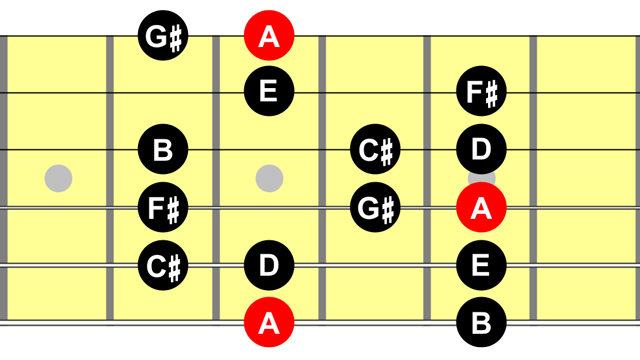
This is Part 2 of the How to Read Guitar Notation series and it’s all about fretboard diagrams. If you haven’t already read it, you should check out Part 1: Chord Boxes.
Fretboard Diagrams
Chord boxes are small and only show a few frets because your left hand can only reach so many notes without moving. But if you need to see more of the neck at one time, like for scales or to show multiple chord shapes on the neck at the same time, you need to use a fretboard diagram. As shown below, a fretboard diagram is a representation of the whole guitar neck—or, more often, a large section of it.

The fretboard is represented with the thin E string (1st string) at the top and the thick E string (6th string) at the bottom. It’s the same view you’d have if you held the guitar in normal playing position (with the neck pointing to the left), slid it down onto your lap, and looked down at it.
The fretboard diagram is basically a chord box turned on its side with lots of other frets added to it. So it shouldn’t be too much of a surprise to learn that the same chord shapes work on both diagrams—they’re just turned on their side. Here’s an A minor chord:
Here’s a D chord:
You get the idea.
One of the main uses for fretboard diagrams is to show scales. To take just one example, here’s an A major scale which is played in 4th position (i.e., your 1st finger is on the 4th fret):

The note markers can just be plain dots or they can be labeled with numbers to show which finger should play each note. Or sometimes, as in this diagram, the note markers are labeled with the actual notes. It’s also common to highlight the root note of the scale in some way; in this case, the “A” notes are red because A is the root of the A major scale.
Now, if you know how to read standard music notation, this same scale would be represented as follows:

Both types of notation have their uses. The fretboard diagram provides a nice visual depiction of the fingering pattern, which can make the scale easier to remember (e.g., you can think “2-4, then 1-2-4, 1-3-4,” etc. to memorize which fingers play on which strings).
A downside of a fretboard diagram is that it’s just a static representation, like a map. It shows you where the notes are but can’t tell you much about how to play them, like what rhythm to use or what order to play them in. Which is fine in a lot of cases—often, you just want to know what the scale pattern is. If you need more than that, that’s where standard notation steps in—it’s more compact and can contain more information like rhythm, tempo, articulations, and so on.
There’s not much else to say about fretboard diagrams; they’re pretty self explanatory! So move on to the next article in this guitar notation series: Part 3: Guitar TAB.




